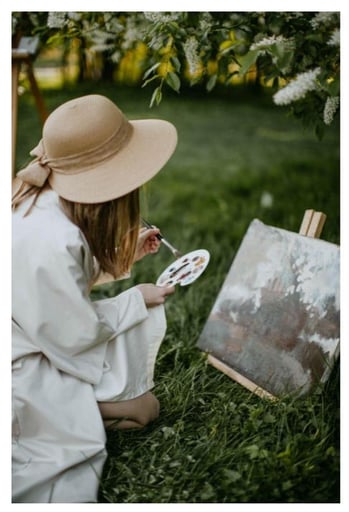
Photo caption: Many artists favor making small paintings when they’re traveling due to how easy the supplies are to transport. Photo courtesy of Valeria Ushakova on Pexels.
There is a vast variety of canvas sizes available. The most common vary from 36 x 48 in. down to 2 x 2 in. mini canvases. How do you choose which size to use? Are there pros and cons to the different sizes?
Choosing the correct size depends on what you’re painting and what your style is. It also depends on where you plan on creating these small pieces. For example, small paintings offer the traveling artist a number of advantages that larger works of art don’t.
In this blog, we’ll focus on composition and what things to consider when working on a small-scale canvas.
Some Basics in Developing Composition
When developing your composition, there are some basics that you should always keep in mind, regardless of the size of canvas you’re using. Let’s review just a few of them.
- Rule of Thirds. The Rule of Thirds refers to a grid that divides your canvas into three sections vertically and horizontally. Your focal point should fall into one of the four cross sections in the grid. All other elements in your painting should draw the viewer’s eye to that focal point. It’s the main character in the drama unveiled on your canvas.
- Varied Values. Value creates the drama on your canvas. It provides the light and shadow in your piece. What areas need to recede away from the viewer? What things do you want to highlight and draw attention to? Make sure you are using a good variety of tints and shades on your value scale. One way to ensure that you have done this is to take a photo and change it to black and white.
- Number of Elements. Typically, it’s best to use an odd number of elements in your paintings. Odd numbers create more visual interest. They hold your gaze more as your eye moves from element to element around the painting.
What’s Different With Small-scale Composition?
When painting on small-scale canvases, there are some different things to consider as you develop your composition. Let’s take the basic examples we stated above and discuss the differences for small-scale projects.
- Rule of Thirds. The general rule for placing your focal point is on the cross sections of the grid. However, with small-scale paintings, you do have the option to put your focal point right in the middle. This would never be recommended on larger canvases. But with the tighter boundaries, a center focal point can work well.
- Varied Values. Sorry, but there are no differences here. A good variety of values is still important to define the light and dark areas of your paintings. Don’t make the mistake of keeping a very small variety of value. It will diminish the effect of your piece. You’ll lose the drama, the illusion of light, and even your focal point. Value is key in all your paintings.
- Number of Elements. Keeping odd numbers is still recommended. Using too many elements can be overwhelming. With a small-scale project you have the opportunity to develop one strong image that draws the viewer in more intimately. Objects should be recognizable from afar, but have the charisma to draw the viewer closer.
Final Thoughts About Small-Scale Composition
More so than in larger paintings, it’s important to take some time to plan your small-scale project. Determine your focal point and other elements you’ll include to draw the viewer’s attention. As you develop your color scheme, keep the importance of a variety of value in mind.
Why not join our Milan Art Community? You’ll find more content like this and much more!
Get More Amazing Content Below!
Quick Tips for Artists: The Vibrant Impact of an Artist’s Brush Strokes
3 Revolutionary Steps to Create Atmosphere in Your Paintings
Art Marketing Tips: 5 Things to do to Prepare for an Art Fair

